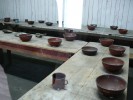- #PL16
- ul. Muzealna 6, Sztutowo, Poland
- +48552478353
- katarzyna.krawczyk@stutthof.org
- http://stutthof.org/english
- Working hours*:
Exhibitions of the museum open daily:
from May 1st to September 30th
8:00 - 18:00
from October 1st to April 30th:
8:00 -15:00 - Prices*:
FREE
Charge only for guided tours. Guides in English or German language available only by request in advance. Sightseeing of the former camp area and the expositions of the museum takes up to 2 hours.
The price for guided tour is 180 PLN / group - * - opening and closing times as well as entrance prices, are subject to alterations without notice. Visitors are advised to check before visiting.
- 54.3282230, 19.1539790 Copy to clipboard Copy
-
#History , #Museums
History
The thought of establishing a camp for "undesirable Polish elements" was born among the Nazi authorities of the Free City of Danzig long before the war broke out. At least since 1936 officials of the police watched and invigilated Polish circles, compiled material which in 1939 served as basis to prepare lists of Poles to be arrested first. In July 1939 a special SS troop was established -"Wachsturmbann Eimann", whose aim was among others to find sites and organize detention camps. In the middle of August 1939 the site for the future concentration camp Stutthof was selected.
The moment the german Nazis invaded Poland, massive arrests of Poles in the Free City of Danzig started. Only in the first day of the war approx. 1500 people were arrested. The victims of arrests were mainly Poles active in social and economical life, activists and members of polish organisations. Among the arrested Poles a group of 150 persons was selected and, as early as on the 2nd September 1939, they were transported to Stutthof. In this moment the tragic story of this camp, a story that lasted for many years, began.
Stutthof served mainly for extermination of the most aware and patriotic Poles, mainly from the educated circles from Danzig and Pomorze Region. Since 1942 transports of Poles arrived and were directed not only by police units from Danzig-West Prussia, but also from other regions of the occupied country. At this time Stutthof became an international camp. In June 1944 it became part of the project "the final solution of the Jewish problem" - "Endloesung". In this way it became a camp of mass- extermination.
Within the 5 years of its existance Stutthof grew from a small camp comprising 12ha in area intended for 3500 prisoners at a time (in 1940) to 120ha and 57 000 prisoners (in 1944). In all it comprised 39 Subcamps.
Stutthof was the place where 110 000 people were kept: men, women and children; citizens of 28 countries and over 30 nationalities. Among them were also Poles, Jews, Russians, Ukrainians, White Russians, Lithuanians, Latvians, Estonians, Czechs, Slovaks, Finns, Norwegians, French, Danes, Dutch, Belgs, Germans, Austrians, English, Spanish, Italians, Yugoslavs, Hungarians and Gypsies. During the imprisonment they were exposed to a number of exterminating factors such as slave-like work, malnutrition, terrible sanitation, disease, mental and physical torture. 65 000 people died as a result of exterminating living conditions as well as of executions by shooting, hanging, murdering in gas chambers by means of Cyclone B, killing by means of phenol injections into the heart, beating and torturing, and during evacuation by land and by sea.
Stutthof was freed on 9th of May by troops of the Soviet Army- the 48th Army of the 3rd White Russian front.









